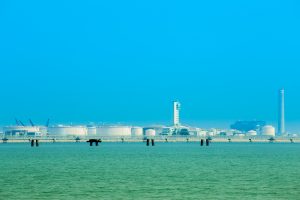In many respects, Thailand is an extremely fortunate nation. It is located in the heart of Southeast Asia with no threat of food shortages, no major state or non-state enemies, and no severe risks of natural disasters (this point, though, is debatable as Thailand is said to be one of the top ten countries in the world most impacted by climate change). But when it comes to energy security, Thais should be concerned.
Thailand is after all a net importer of oil and natural gas, and its existing reserves – most notably the one in the Gulf of Thailand – are running low. To satisfy its people’s skyrocketing demand, the Thai government does not have much of a choice but to keep relying on imported energy sources (and grudgingly accepting rising prices in the process).
Much of Thailand’s imported energy comes from Myanmar, meaning that the Thais are prone to disruptive events next door. In 2015, for instance, Thailand was estimated to consume a total of 4,400 million standard cubic feet of gas per day (MMSCFD) and Myanmar’s pipeline repair resulted in the loss of 1,100 MMSCFD. Such reliance also indicates that forces in Myanmar, the governing military and ethnic rebel groups alike, have considerable coercive power over the Thai government.
Energy transition combined with diversification, therefore, constitutes a crucial and highly challenging priority for Thai policymakers and politicians. And nuclear energy, which is supposedly a relatively sustainable and clean alternative source of energy, has constantly been brought up.
In a way, it is ironic that Thailand and many of its Southeast Asian neighbors that have pledged to preserve the region as a nuclear weapons free zone have long demonstrated a keen interest in utilizing nuclear power to generate electricity – something that anti-nuclear campaigners say could enhance risks of nuclear proliferation and terrorism. Thailand was in fact the first Southeast Asian state to run a nuclear research reactor in 1962. Then, in the early 1970s, there was a concrete plan to build the first nuclear power plant in Chon Buri province, now a part of Thailand’s Eastern Special Development Zone for technological manufacturing. But this, as well as subsequent proposals to construct a nuclear power plant, never materialized due to a combination of high costs, time lag between preparation and operation, and widespread public radiophobia.
The Power Development Plan (PDP), Thailand’s main energy blueprint, which gets revised every three to four years, from 2007 onwards contained plans for the construction of nuclear power plants. The nuclear section was eventually omitted from PDP 2018, which underscored the downward global trend in nuclear energy use. The latest draft PDP 2022, which is expected to be officially released this year, also appears to disregard the nuclear dimension. Meanwhile, key political parties from both the pro-establishment and reformist camps have logically concentrated their attention on solar energy as an alternative energy source.
Despite the downplaying of nuclear elements, the long-running (and controversial) project to build a 20-megawatt nuclear reactor site in the Ongkharak district of Nakhon Nayok province in central Thailand has not been scrapped. More significantly, conversations about portable smaller nuclear reactors that could potentially address the problems of costs and safety surrounding conventional nuclear reactors seem to be getting louder after the United States offered to provide Thailand with technical assistance. The move, which manifested in November of last year, was a component of the Biden administration’s “Net Zero World Initiative” to tackle climate change.
Ultimately, as stressed by Tipakson Manpati in an article published by Germany’s Heinrich Böll Foundation, Thai authorities have never seriously discarded their nuclear agenda and new developments in this area are worth paying close attention to.
Whether small nuclear reactors will really help Thailand cope with its energy and climate headaches remains to be seen. Instead, the question that matters at this point is how Thai authorities can shape public acceptance. Trust in government institutions is already low, and past nuclear disasters in Chernobyl and Fukushima continue to fuel the anti-nuclear sentiment.
Public wariness in Thailand is actually on the rise following a recent scare involving a missing radioactive material. On February 23, amid messy party switching and the rolling out of populist policies by various parties ahead of the upcoming May general election, a steel tube containing the Caesium-137 radioactive substance mysteriously disappeared from a steam power plant in Prachin Buri province near the densely populated capital Bangkok. About two weeks later, the disappearance was brought to public attention, and it was far from clear who should be held accountable. The dangerous Caesium-137 material was finally detected on March 19 at a forging factory, reportedly as an already forged object, which has unsurprisingly raised serious health concerns. Still, many important questions about the incident remain unanswered.
Thailand’s safety culture and institutional safeguards clearly require a major reboot. As it stands, going nuclear will bring more perils than promises.

































